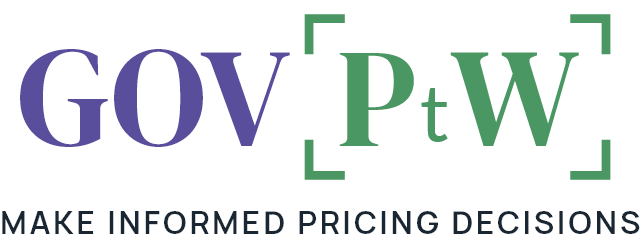The Price to Win (PTW) process is the confluence between three qualitative and quantitative intelligence gathering efforts, and a defined business development process. The three intelligence gathering efforts , which we call The Triangle, are:
- The Client
- The Competition
- The Bid/Outcome
The 3 ‘The Triangle‘ articles will further explore each of these areas.
The defined business development process can be anything that your company chooses but for this article we reference the Shipley Color Teams:
| Color Team | Team Purpose |
| Blue | assess the capture plan and strategy |
| Black | predict competitors’ likely solutions and strategies |
| Pink | verify compliance and execution of your win strategy, also usually a proposal outline is reviewed |
| Red | predict how your proposal will be scored and make improvements to it, also usually the written proposal is reviewed |
| Green | review the PTW analysis, recommendation, and approve pricing |
| Gold | confirm your proposal incorporates necessary changes from the color teams, and is ready for the proposal submittal decision, a formal and complete review of risks is done during this time |
| White | record lessons learned and make process improvements |
PTW is present during all facets of The Triangle and Color Team reviews. The most deliberate discussions on PTW however, occur during:
- Blue – how do our companies’ price position fit into the buyers budget
- Black – how does our tentative price compare to that of our likely competitors
- Green – formal PTW discussion
- Gold – confirm the final price and discussion and make sure any price related risks are identified and mitigated or accepted
- White – how did our price fair in the competition
- Pink/Red – there may be price discussions around them but usually no formal price review
Blue (capture & strategy)
In this stage you are focused on an analysis of the client. Some PTW questions that need answering during this stage include:
- What are the clients’ buying behaviors and preferences that impact price?
- Do they favor Lowest Price Technically Acceptable (LPTA) or Best Value Tradeoff (BVT)?
- What type of contract is this likely to be (Firm Fixed Price, Cost Plus, etc)?
- Do you need a strategic hire and if so what is the likely cost for that?
- How does a strategic hire or broader staffing strategy fit into our PTW strategy?
- What is the client’s probable budget and what does that mean for our approach and solution?
- Is there is an incumbent? If so what is the current contract value and how does that factor into our solution’s Rough Order of Magnitude (ROM) price?
The above facilitates either a formal or informal Green team at this stage
Black (competition)
What is going on with our competition? Some PTW questions for this phase include:
- Who are the likely competitors? If there is an incumbent we know at least one (unless they are excluded from the follow-on competition).
- What are the competitors likely approaches? For example, if a competitor is known for using a certain technology stack that reduces labor costs by 5%, then you need to be observing that now. Do you need to integrate that same technology stack or perhaps something similar that increases efficiencies and reduces labor costs? It is far easier and less expensive to make that determination now rather than during the Pink or Red process in the midst of writing the technical approach.
- What tools and/or techniques are out there that you could incorporate and the client would want/favorably evaluate, regardless of whether any identified competitors are likely to use it?
- What does the PTW window look like?
- What is the likely PTW, and how do we compare to it?
The above facilitates another either a formal or informal Green team that now includes competitor data points.
Pink (proposal outline)
The proposal is off to the races and the outline is reviewed. From a PTW standpoint you should be updating the PTW model based on new information received from:
- the solicitation (e.g. amendments, questions & answers)
- competitive intelligence
- pricing from our subcontractor, etc.
Preparation for an updated PTW analysis /Green Team should be a major focus
Red
The proposal is now written and evaluated by the company’s internal and/or external stakeholders. PTW activities are the same as that in Pink.
Green
The PTW Window (see later article) and analysis is reviewed and a final price is determined by company leadership. This should NOT be the first time price is discussed. A green team should occur in several places during the pursuit, and at least one should be done around the blue/black, especially for large dollar value opportunities.
Gold
The PTW Window and final price is re-reviewed and confirmed. The price is then transferred into the Government’s format and the final ‘i’s are dotted and ‘t’s are crossed.
White
This may occur either soon after the proposal is submitted, or done after the Government’s award decision. You should compare how the company’s PTW analysis, and competitor analysis compared to the what the Government shared in the debrief. Any discrepancies should be evaluated and process adjustments and/or improvements committed to company memory.
Conclusion
PTW is about collecting as many relevant data points as is possible so that informed decisions may be made as early and as often as is possible/necessary. A data point discovered weeks or months after it was available may negatively impact the strategy, pWin, and/or the proposal cost.
In our next article we introduce, and discuss in depth, the Price to Win window which sets up later articles brining all of this information together into the PTW analysis and recommendation.
